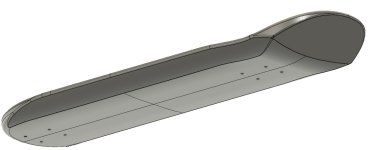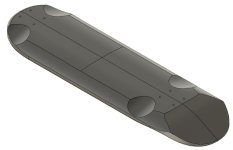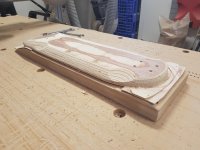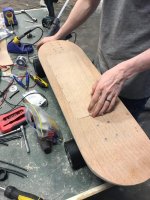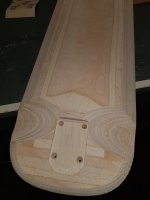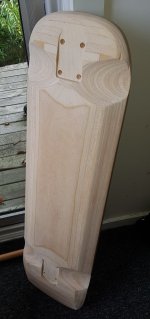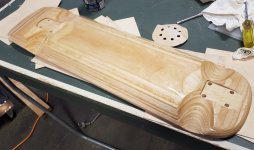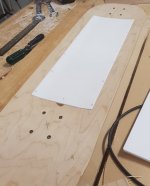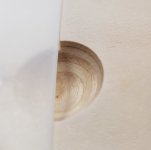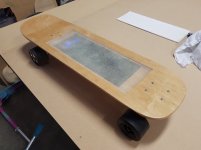Ohbse
10 kW
A few people expressed an interest in what I've been cooking - so I thought I should keep a log and maybe inspire some others to jump in.
I've long wanted to build an electric skateboard, mostly for fun and to make for the occasional short trip around the CBD or to and from the train station. Unlike my daily ride Giant DH which is hideous but purely practical, I wanted this to be more 'finished' and maybe even beautiful.
Design considerations in no particular order:
Moderate speed - while I might be a bit of a speed freak on two wheels, I have little desire to push it on 4 tiny ones. Physics isn't on my side, plus I haven't got a ton of skate experience and something that does 40mph would probably get me hurt. Target here is ability to cruise at 30km/h safely.
Kicktail - I wanted one for low speed maneuverability and kinda for looks too.
Hub motors - I don't want to deal with belts and pulleys, they suck for packaging, visuals, maintenance and noise. Hub motors have come a long way in the e-skate world with some pretty okay-ish chinese offerings. I'm not going for absolute performance, ride quality or lots of distance, so starting with a cost effective option should be fine. I bought a set of 90mm x 52mm "1000watt" hubs from diyeboard
Internal battery/controller etc - I don't like the look or the practicalities of having a pregnant guppy enclosure bolted to the bottom of the board. Water ingress is a pain.
18650's - I built a 10s3p pack of Samsung 30Q's - this will comfortably do 1500watt of output which I figured should be plenty for my moderate speed and range requirements.
Smooth silent controllable power - I didn't want something that was slow, strained or unreliable. Control is everything and FOC was highly desirable from a sound perspective. I bought a dual VESC 4.2 from Flipsky
Maple veneer, vacuum bag over mold deck - I was inspired by decks like the Evolve Carbon GT with a top mounted access hatch, but I didn't want to get into the potential pitfalls of composite construction - you can look around to see lots of people have had issues with the carbon decks with a variety of cracking issues or even catastrophic failure - no thanks! I opted for a more forgiving and traditional skateboard building material, Canadian rock maple veneers. I also wanted to learn about the molding and vacuum layup process. As an entry point I bought a full kit from Roarockit, 3x longboard 'kits' of 7 ply each, vacuum bag and a hand pump.
More to come (with pics!)
I've long wanted to build an electric skateboard, mostly for fun and to make for the occasional short trip around the CBD or to and from the train station. Unlike my daily ride Giant DH which is hideous but purely practical, I wanted this to be more 'finished' and maybe even beautiful.
Design considerations in no particular order:
Moderate speed - while I might be a bit of a speed freak on two wheels, I have little desire to push it on 4 tiny ones. Physics isn't on my side, plus I haven't got a ton of skate experience and something that does 40mph would probably get me hurt. Target here is ability to cruise at 30km/h safely.
Kicktail - I wanted one for low speed maneuverability and kinda for looks too.
Hub motors - I don't want to deal with belts and pulleys, they suck for packaging, visuals, maintenance and noise. Hub motors have come a long way in the e-skate world with some pretty okay-ish chinese offerings. I'm not going for absolute performance, ride quality or lots of distance, so starting with a cost effective option should be fine. I bought a set of 90mm x 52mm "1000watt" hubs from diyeboard
Internal battery/controller etc - I don't like the look or the practicalities of having a pregnant guppy enclosure bolted to the bottom of the board. Water ingress is a pain.
18650's - I built a 10s3p pack of Samsung 30Q's - this will comfortably do 1500watt of output which I figured should be plenty for my moderate speed and range requirements.
Smooth silent controllable power - I didn't want something that was slow, strained or unreliable. Control is everything and FOC was highly desirable from a sound perspective. I bought a dual VESC 4.2 from Flipsky
Maple veneer, vacuum bag over mold deck - I was inspired by decks like the Evolve Carbon GT with a top mounted access hatch, but I didn't want to get into the potential pitfalls of composite construction - you can look around to see lots of people have had issues with the carbon decks with a variety of cracking issues or even catastrophic failure - no thanks! I opted for a more forgiving and traditional skateboard building material, Canadian rock maple veneers. I also wanted to learn about the molding and vacuum layup process. As an entry point I bought a full kit from Roarockit, 3x longboard 'kits' of 7 ply each, vacuum bag and a hand pump.
More to come (with pics!)


